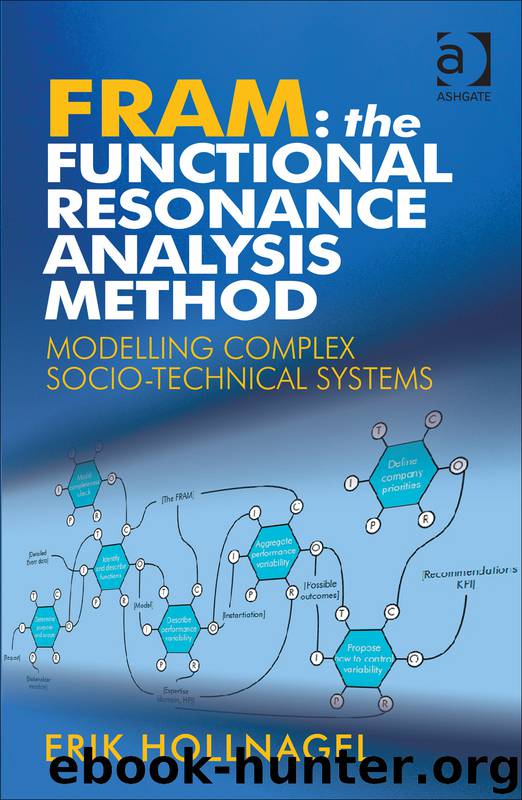FRAM: The Functional Resonance Analysis Method by Erik Hollnagel

Author:Erik Hollnagel
Language: eng
Format: epub
Publisher: Ashgate
Published: 2012-03-11T16:00:00+00:00
Comments on Chapter 5
A Hierarchical Task Analysis (HTA) basically decomposes tasks into sub-tasks and repeats this process until a level of elementary tasks has been reached. The overall aim is to describe the task in sufficient detail, where the level of resolution required depends on the specific purposes, for example, interaction design, training requirements, interface design, risk analysis and so on. Descriptions of HTA can be found in many handbooks, as well as on the web. The original reference is Annett, J. and Duncan, K. D. (1967), ‘Task analysis and training design’, Occupational Psychology, 41, 211–221.
As an aside, the now-ubiquitous flowchart can be traced back to the ‘process charts’ of ‘flow process charts’ created by Frank Gilbreth in 1921 to illustrate the flow of work processes or, in other words, an early form of task analysis. In 1947 it became a basic technique of representation for computer programming, and has since spread to all kinds of professional activities.
The Structured Analysis and Design Technique (SADT) was described by Ross, D. T. (1977), ‘Structured analysis (SA): A language for communicating ideas’, IEEE Transactions on Software Engineering, SE-3(1), 16–34. The technique was developed in the field of software engineering but has also been used to model the functions of a power plant in a safety analysis.
The characterisation of the various temporal relations first appeared in Allen, J. (1983), ‘Maintaining knowledge about temporal intervals’, Communication of the ACM, 26, 832–843. It remains a highly readable paper.
The realisation that human performance depends on the conditions can be found in the origins of scientific psychology, around 1879, but is certainly much older than that. It was an important part of the Technique for Human Error Rate Prediction (THERP), which arguably is the best known first-generation HRA method. THERP was described in Swain, A. D. and Guttmann, H. E. (1983), Handbook of Human Reliability Analysis with Emphasis on Nuclear Power Plant Applications, NUREG/CR-1278, USNRC.
Download
This site does not store any files on its server. We only index and link to content provided by other sites. Please contact the content providers to delete copyright contents if any and email us, we'll remove relevant links or contents immediately.
Whiskies Galore by Ian Buxton(40620)
Introduction to Aircraft Design (Cambridge Aerospace Series) by John P. Fielding(32367)
Small Unmanned Fixed-wing Aircraft Design by Andrew J. Keane Andras Sobester James P. Scanlan & András Sóbester & James P. Scanlan(32155)
Craft Beer for the Homebrewer by Michael Agnew(17472)
Turbulence by E. J. Noyes(7078)
The Complete Stick Figure Physics Tutorials by Allen Sarah(6657)
Kaplan MCAT General Chemistry Review by Kaplan(6083)
The Thirst by Nesbo Jo(5814)
Bad Blood by John Carreyrou(5798)
Learning SQL by Alan Beaulieu(5445)
Weapons of Math Destruction by Cathy O'Neil(5068)
Man-made Catastrophes and Risk Information Concealment by Dmitry Chernov & Didier Sornette(4770)
iGen by Jean M. Twenge(4713)
Digital Minimalism by Cal Newport;(4605)
Life 3.0: Being Human in the Age of Artificial Intelligence by Tegmark Max(4534)
Audition by Ryu Murakami(4122)
Electronic Devices & Circuits by Jacob Millman & Christos C. Halkias(4061)
1,001 ASVAB Practice Questions For Dummies by Powers Rod(4055)
Pale Blue Dot by Carl Sagan(4031)
